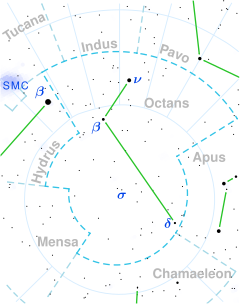
| |
| Observation data Epoch J2000.0 Equinox J2000.0 (ICRS) | |
|---|---|
| Constellation | Octans |
| Right ascension | 23 28 03.7855 |
| Declination | −87° 28′ 55.967″ |
| Apparent magnitude (V) | 5.50 |
| Characteristics | |
| Spectral type | K2 III |
| U−B color index | +1.43 |
| B−V color index | +1.27 |
| Astrometry | |
| Radial velocity (Rv) | 31.0±1.4 km/s |
| Proper motion (μ) | RA: +16.782 mas/yr Dec.: +11.957 mas/yr |
| Parallax (π) | 6.8009 ± 0.0574 mas |
| Distance | 480 ± 4 ly (147 ± 1 pc) |
| Absolute magnitude (MV) | −0.36 |
| Details | |
| Mass | 1.14 M☉ |
| Radius | 24 R☉ |
| Luminosity | 223 L☉ |
| Surface gravity (log g) | 1.63 cgs |
| Temperature | 4,422 K |
| Metallicity | +0.12 dex |
| Rotational velocity (v sin i) | <1 km/s |
| Other designations | |
| τ Oct, 81 G. Octantis, CPD−88°204, FK5 925, GC 32558, HD 219765, HIP 115836, HR 8862, SAO 258970 | |
| Database references | |
| SIMBAD | data |
Tau Octantis, Latinized from τ Octantis, is a solitary star in the southern circumpolar constellation Octans. It has an apparent magnitude of 5.50, allowing it to be faintly seen with the naked eye. The object is located at a distance of 480 light years but is receding with a heliocentric radial velocity of 31 km/s.
Tau Octantis has a stellar classification of K2 III, indicating that the object is a red giant. It has 114% the mass of the Sun but is 223 times as luminous. However, an enlarged radius of 24 R☉ yields an effective temperature of 4,422 K, giving it an orange glow. Tau Octantis has an iron abundance 132% that of the Sun and is believed to be a member of the old disk population. Currently, it spins with a projected rotational velocity less than 1 km/s.
References
- ^ Brown, A. G. A.; et al. (Gaia collaboration) (2021). "Gaia Early Data Release 3: Summary of the contents and survey properties". Astronomy & Astrophysics. 649: A1. arXiv:2012.01533. Bibcode:2021A&A...649A...1G. doi:10.1051/0004-6361/202039657. S2CID 227254300. (Erratum: doi:10.1051/0004-6361/202039657e). Gaia EDR3 record for this source at VizieR.
- ^ Anderson, E.; Francis, Ch. (May 2012). "XHIP: An extended hipparcos compilation". Astronomy Letters. 38 (5): 331–346. arXiv:1108.4971. Bibcode:2012AstL...38..331A. doi:10.1134/S1063773712050015. ISSN 1063-7737. S2CID 255204555.
- Houk, N.; Cowley, A. P. (1975). University of Michigan Catalogue of two-dimensional spectral types for the HD stars. Volume I. Declinations -90_ to -53_ƒ0. Bibcode:1975mcts.book.....H.
- ^ Johnson, H. L.; Mitchell, R. I.; Iriarte, B.; Wisniewski, W. Z. (1966). "UBVRIJKL Photometry of the Bright Stars". Communications of the Lunar and Planetary Laboratory. 4: 99–110. Bibcode:1966CoLPL...4...99J.
- ^ Gontcharov, G. A. (November 2006). "Pulkovo Compilation of Radial Velocities for 35 495 Hipparcos stars in a common system". Astronomy Letters. 32 (11): 759–771. arXiv:1606.08053. Bibcode:2006AstL...32..759G. doi:10.1134/S1063773706110065. eISSN 1562-6873. ISSN 1063-7737. S2CID 119231169.
- ^ Anders, F.; et al. (August 2019). "Photo-astrometric distances, extinctions, and astrophysical parameters for Gaia DR2 stars brighter than G = 18". Astronomy & Astrophysics. 628: A94. arXiv:1904.11302. Bibcode:2019A&A...628A..94A. doi:10.1051/0004-6361/201935765. ISSN 0004-6361.
- Stassun, Keivan G.; et al. (9 September 2019). "The Revised TESS Input Catalog and Candidate Target List". The Astronomical Journal. 158 (4): 138. arXiv:1905.10694. Bibcode:2019AJ....158..138S. doi:10.3847/1538-3881/ab3467. ISSN 0004-6256.
- ^ McDonald, I.; Zijlstra, A. A.; Boyer, M. L. (21 November 2012). "Fundamental parameters and infrared excesses of Hipparcos stars: Parameters and IR excesses from Hipparcos". Monthly Notices of the Royal Astronomical Society. 427 (1): 343–357. arXiv:1208.2037. Bibcode:2012MNRAS.427..343M. doi:10.1111/j.1365-2966.2012.21873.x. ISSN 0035-8711.
- ^ Eggen, O. J. (July 1993). "Evolved GK stars near the sun. I - The old disk population". The Astronomical Journal. 106: 80. Bibcode:1993AJ....106...80E. doi:10.1086/116622.
- ^ De Medeiros, J. R.; Alves, S.; Udry, S.; Andersen, J.; Nordström, B.; Mayor, M. (January 2014). "A catalog of rotational and radial velocities for evolved stars: V. Southern stars⋆⋆⋆". Astronomy & Astrophysics. 561: A126. arXiv:1312.3474. Bibcode:2014A&A...561A.126D. doi:10.1051/0004-6361/201220762. ISSN 0004-6361.
- Eggleton, P. P.; Tokovinin, A. A. (3 September 2008). "A catalogue of multiplicity among bright stellar systems". Monthly Notices of the Royal Astronomical Society. 389 (2): 869–879. arXiv:0806.2878. Bibcode:2008MNRAS.389..869E. doi:10.1111/j.1365-2966.2008.13596.x. S2CID 14878976.
| Constellation of Octans | |||||||||||
|---|---|---|---|---|---|---|---|---|---|---|---|
| Stars |
| ||||||||||
| |||||||||||
| Galaxies |
| ||||||||||